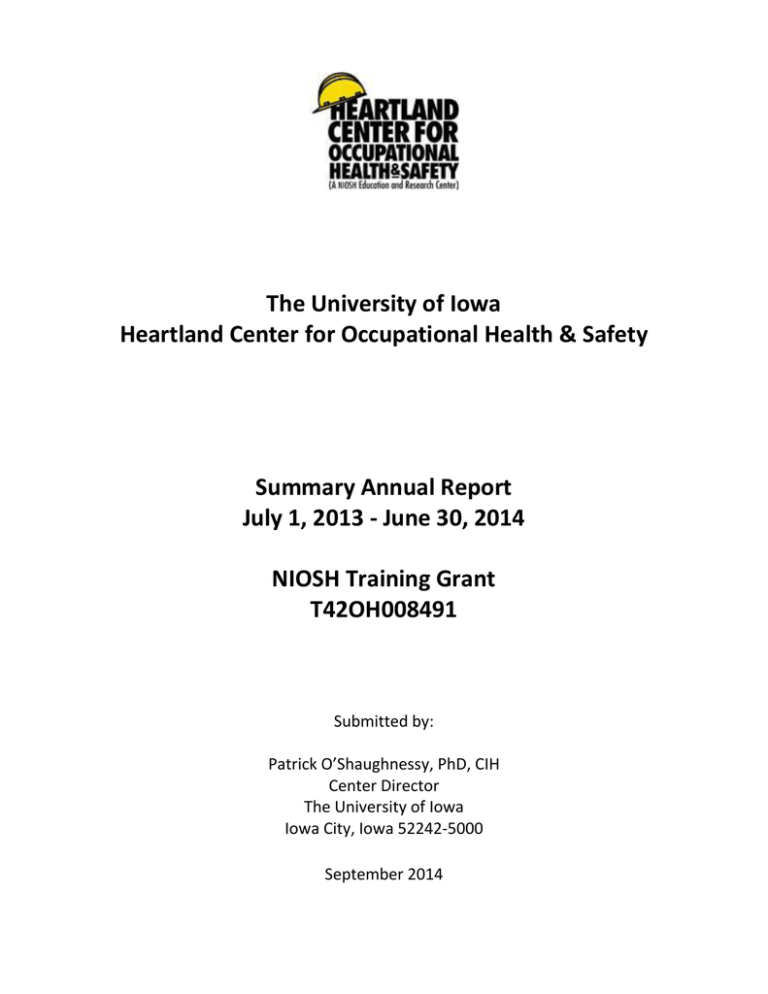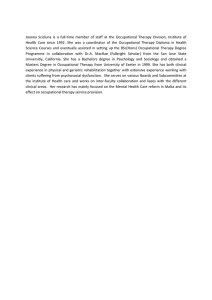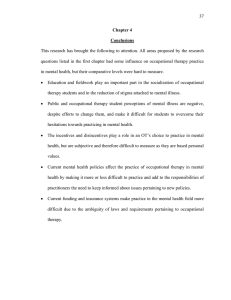The University of Iowa Heartland Center for Occupational Health & Safety
advertisement

The University of Iowa Heartland Center for Occupational Health & Safety Summary Annual Report July 1, 2013 ‐ June 30, 2014 NIOSH Training Grant T42OH008491 Submitted by: Patrick O’Shaughnessy, PhD, CIH Center Director The University of Iowa Iowa City, Iowa 52242-5000 September 2014 Iowa ERC – July 1, 2013-June 30, 2014 SECTION I ERC Summary The mission of the Heartland Center for Occupational Health and Safety, a NIOSH Education and Research Center, is to help reduce injuries, illnesses, and fatalities of workers in Federal Region VII (Iowa, Kansas, Missouri and Nebraska) and beyond by expanding and strengthening the occupational health and safety workforce with well-trained practitioners and well-informed professionals. Since its inception in 2000, the Heartland Center for Occupational Health and Safety (the Center) has served as a resource for Federal Region VII and the US, providing interdisciplinary graduate, postgraduate, and residency training, continuning education and outreach for practitioners and researchers in occupational health and safety (OHS) professions. The major rationale for the Center is to address dual problems in Federal Region VII: higher than US-average rates of occupational disease and injury and shortages of trained OHS professionals. This Center is well positioned to address OSH issues unique to the region by preparing trainees with knowledge and experience in the discipline areas most relevant to the needs of workers in this region. The Center has 6 graduate-level training programs, including agricultural safety and health, ergonomics, industrial hygiene, occupational epidemiology, occupational injury prevention, and occupatonal medicine. The Center’s active continuing education and outreach programs reach thousands of practitioners in the Region, utilizing both traditional educational media and methods a well as innovative distance-education technology. Heartland Center strengths include the breadth and depth of faculty, our strong emphasis on interdisciplinary training and research, an active Continuing Education (CE) Program, and institutional support of Center activities. Relevance The training of over 40 graduate-level students by Center faculty directly influences the number of trained occupational health and safety professionals available to Federal Region VII and elsewhere in the United States. Annually, we graduate students who obtain jobs in industry, academia, and government agencies. The continuing education provided to more than 1200 professionals annually in this Region has strengthened their ability to reduce the high regional rates of occupational disease and injury. The Center also reaches out to over 13,000 regional businesses involving 411,000 workers through a unique outreach program that provides consultation, continuing education, and current OSH information to increase awareness of occupational health and safety and reduce illness and injury. Key Personnel Patrick O’Shaughnessy, PhD, Center Director – 319.335.4202, patrick-oshaughnessy@uiowa.edu Kimberly Gordon, MSN, Deputy Director, Continuing Education Director, Outreach Director – 319.335.4423, kimberly-gordon@uiowa.edu David Asa, MS, Associate Director of Student Affairs – 319.335.4558, david-asa@uiowa.edu Diane Rohlman, PhD, Director, Agricultural Safety & Health – 319.384.4007, diane-rohlman@uiowa.edu Nathan Fethke, PhD, Director, Ergonomics – 319.467.4653, nathan-fethke@uiowa.edu R. William Field, PhD, Director, Occupational Epidemiology, Pilot Program Director – 319.335.4413, bill-field@uiowa.edu Fredric Gerr, MD, Director, Occupational Medicine Residency – 319.335.4212, fred-gerr@uiowa.edu Thomas Peters, PhD, Director, Industrial Hygiene – 319.335.4436, thomas-m-peters@uiowa.edu Corinne Peek-Asa, PhD, Director, Occupational Injury Prevention Research – 319.335.4895, corrine-peek-asa@uiowa.edu ERC Web Link http://www.public-health.uiowa.edu/heartland/ 1 Iowa ERC – July 1, 2013-June 30, 2014 SECTION II The 2013-14 reporting period comprised several high impact accomplishments of Center faculty, staff, and trainees: The Industrial Hygiene Program has numerous faculty and research highlights. Dr. Renee Anthony was promoted to associate professor with tenure, and Dr. Patrick O’Shaughnessy was inducted as fellow in AIHA. We continue to do high quality research with trainees with an emphasis on aerosol research. We have projects to protect agricultural workers: control of dust in swine barns (Anthony); use of respirators among swine (Nonnenmann); and development of new respirators for agriculture (O’Shaughnessy). We are working to improve assessment tools: development of inhalable samplers (Anthony); detection of airborne virus (Nonnenmann); development and field testing of a nanoparticle respiratory deposition sampler (Peters); and use of low-cost monitors to assess exposures for ozone, noise, and aerosols (Peters). We also have work to evaluate community exposures to respirable crystalline silica from sand mining and related activities (O’Shaughnessy/Peters). We are developing training material for occupational and environmental professionals for safe handling of nanomaterials (Peters). Our program received full ABET accreditation. Our students presented 9 posters at AIHce, winning two awards: Girlando from the Biosampling Committee; and Levi Mines from the Aerosol Technology Committee. Our recent alumni have passed important milestones. Several alumni have become certified industrial hygienists (Will Cyrs, Lindsay Parker, Nor Rahmah Binti Nor Hashim, and Justin Newnum). Ron Johnson and Lindsay Parker passed their certified safety professional examinations. Brian Pavilonis became an assistant professor in the Environmental and Occupational Health Sciences at Hunter College. Mike Human, Alisha Meyers, and Lorenzo Cena successfully competed for NIOSH internal funding to support their research efforts. Graduates of the Occupational Medicine Residency Program include Shirley Pospisil, MD, MPH, a 2008 graduate who is now the Medical Director at St. Luke’s Work Well in Cedar Rapids, Iowa. Laura Breeher, MD, MPH, MS, is the first author of a peerreviewed journal article (Breeher LE, Gerr F, Fuortes L. Adult lead toxicity following use of Ayurvedic herbal medication. Journal of Occupational Medicine and Toxicology, 8(1):26; 2013). Dr. Breeher is currently practicing occupational medicine and working to expand an occupational medicine clinic in Minnesota. Our graduates are not the only ones impacting health and safety. Current resident, Sophia Chiu, MD, MSc, has been awarded a pilot research grant, “Transitioning from School to Work: Total Worker Health in Young Adults”. Dr. Chiu also submitted an abstract, “Where do Agricultural Producers Get Health and Safety Information?” for the SHARP 7th International Symposium in Saskatoon, SK, Canada. Her abstract was accepted and she will be presenting at the International Symposium in October 2014. The Occupational Injury Prevention Program has had a year of great student success. Three of our trainees have successfully competed for pilot grants to fund their independent dissertation work. Doctoral student Laura Schwab-Reese received a pilot grant from the Injury Prevention Research Center to conduct analyses of the Longitudinal Adolescent Health Data to examine youth work, health indicators, and violence. Maisha Toussaint received a pilot grant from the Heartland Center to study youth employment, youth violence, school engagement. Kayla Smith received a pilot award from the Midwest Transportation Research Center to examine transportation safety using the National Advanced Driving Simulator. MD/PhD student Amanda Swanton gave a presentation titled “Do Farmers Experience Delays in Reaching Definitive Trauma Care Following Occupational Injury?” at the International Society for Agricultural Safety and Health and was awarded the ISASH Endowment Award. Laura Schwab-Reese, who will graduate this year, was elected as the student member of the Board of Advisors for the Society for the Advancement of Violence and Injury Research, and she also serves as the chair of the APHA Injury Prevention and Emergency Health Services membership committee. This year, our trainees presented at more than 12 national scientific meetings and authored five publications with five more under preparation. One objective of the Heartland Center’s Ergonomics Training Program is to provide our trainees with the educational background and experience necessary to obtain professional certification from the Board of Certification in Professional 2 Iowa ERC – July 1, 2013-June 30, 2014 Ergonomics (BCPE). The BCPE is regarded as the premier credentialing organization for human factors and ergonomics practitioners. During the past year, one former trainee (Gant, PhD 2012) obtained the full Certified Professional Ergonomist (CPE) credential and one current trainee (Schall) obtained the interim Associate Ergonomics Professional credential. In addition, Dr. Fethke obtained a five-year continuation of his CPE credential. Ergonomic Training Program graduates and faculty have made meaningful contributions to national and international organizations’ efforts to develop consensus standards that provide important guidance to human factors and ergonomics researchers and practitioners. Lauren Gant, PhD, CPE, a 2012 graduate and the Human Factors and Ergonomics Manager for the HNI Corporation, participates on the Human Factors and Ergonomics Society’s (HFES) subcommittee for Human Factors Engineering of Computer Workstations. The subcommittee has been working on revisions to the American National Standards Institute (ANSI)/HFES 100 standard. In addition, the International Organization for Standardization (ISO) working group addressing the interaction between posture and whole-body vibration, for which Ergonomics Training Program faculty Dr. David Wilder is the founding convener, recently promulgated its first product (ISO/TR 10687 Mechanical vibration – description and determination of seated postures with reference to whole-body vibration). The Agricultural Safety and Health Program has contributed to a newsworthy story during this past year focusing on individuals trapped in grain bins. In order to demonstrate to students the hazards of working in grain bins and the difficulty of conducting a rescue operation, we buried a student in feed corn in a grain bin, and then rescued her. This grain entrapment rescue training was part of the Rural Health and Agricultural Medicine class taught in the College of Public Health at the University of Iowa. In partnership with the National Education Center for Agricultural Safety at the Northeast Iowa Community College, we arranged for this demonstration of grain bin rescue methods on the University of Iowa campus. The story was covered by the College of Public Health, in the local news (KCRG), and in a radio interview with Mike Devine from AM1400 in Fort Dodge/Mason City. The demonstration had an impact not only on the students in the class, but also members of the College of Public Health, stakeholders, including local politicians who were invited to participate, and community members across the state who watched the news or heard the radio story. 3



